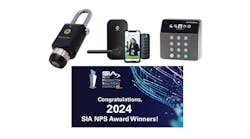Adams Rite Adds Dual Lever Hardware to RITE Door
PHOENIX, AZ –Adams Rite, an ASSA ABLOY Group company, has launched the newest addition to the RITE Door family of hardware, the D3940 Series dual levers.
The Adams Rite D3940 Series dual levers on either side of The TRUE Wood RITE Door activate the top latching mechanism, allowing each leaf to operate independently and eliminating the need for floor strikes, center latches, flush bolts, astragals or coordinators. All pre-installed lever x lever hardware features the free-wheeling lever mechanism, so when the outside lever is locked, it will rotate freely up and down while remaining securely locked and is also available electrified for access control. The D3976 fire-rated inset concealed vertical rod exit device, launched in May, ensures clear opening, code compliance and a clean look. The RITE Door from Adams Rite is integrated commercial door system that meets all fire and safety regulations, is easy to install and enhances your design.
“Custom is king. Just as we’ve made the RITE Door and TRUE Wood to be incredibly customizable to fit your installation needs, we’ve also expanded our exit device offering to both inset and dual lever hardware,” said Curt Hubacher, Contract Hardware Channel Manager, EMS & OEM Group, ASSA ABLOY. “Dual levers are ideal for educational facilities, hospitality, hospitals and commercial applications. The series is available in three designs and multiple color options, to yet again ensure the perfect match for your facility.”
The new TRUE Wood RITE door is available in several types; the GPD-EC 5-Ply engineered composite lumber core for Non Rated and 20 minute rating, and the GPD-FD 5-Ply fire core with fire ratings ranging from 45 to 90 minutes. A variety of product options are also available including silent electrification (SE) motorized latch retraction, request to exit (REX) monitoring/signal switches, and electric dogging. All of the TRUE Wood doors are available in a wide variety of vertical and horizontal grain patterns and may contribute to the following four LEED 3.0 credits: MR4, MR5, MR7 and IEQ 4.4. The RITE Door has been awarded GREENGUARD Indoor Air Quality Certification®.
For more information, visit www.ritedoor.com.
Von Duprin Concealed Exit Devices Fill Church’s Tall Order
When St. Francis of Assisi Catholic Church in Frisco, Texas, needed a way to secure pairs of 14-foot tall bronze doors in its new church, it found the answer in exit devices with the Von Duprin® Concealed Vertical Cable (CVC) system from Allegion.
The doors were part of a major project that included a new 1,650-seat church with a design inspired by its namesake in Italy, as well as a 350-seat chapel dedicated to St. Clare, a follower of St. Francis. Previously, the church was meeting in its parish center, a multi-purpose building that held as many as 923 people. Both new buildings were dedicated in December, 2013.
When the church decided to expand and build the new structures, it created a building committee to plan and oversee the project. Kevin Bird, a member of the parish with a background in commercial development, was hired as the owner’s representative to manage development and construction.
The church and chapel entries both feature special pairs of doors. Bird says the doors are constructed of bronze panels engraved with patterns reflecting St. Francis’s love of nature. One pattern is “The Rain,” while the other also symbolizes themes of the earth. According to Bird, the size of the doors presented a challenge to Forms + Surfaces, the architectural products company that produced the panels.
“They said they never had engraved anything that large,” Bird explains, “so we had to encourage them to push the envelope. I wouldn’t take ‘no’ for an answer.”
The church doors each measure 4 x 14 feet, while the chapel doors measure 3 x 10 feet. While building codes required exit devices for safe egress, considerations such as security, aesthetics and accessibility dictated the use of a concealed system rather than mullions with rim devices. Bird explains, “We needed a full-width opening to allow us to bring caskets through the doors for funerals.” However, the extra door height required the use of rod extensions and would have complicated installation, adjustment and maintenance.
Unlike vertical rods, the CVC system selected for the doors uses a flexible, enclosed cable system that installs as an assembly. Its ease of adjustment simplifies installation and the top and bottom latches operate independently to ensure secure latching. After installation, the bottom latch can be adjusted while the door is hanging. The system uses stainless steel cables with a Teflon® liner to prevent corrosion and increase the strength of the system.
Other hardware solutions used in the new church include CO-Series standalone electronic locks by Schlage, which provide the security, efficiency and convenience of electronic locks without the cost or complexity of a fully networked system. These locks provide added security for areas such as the sacristies, choir room and counting room. They allow entrance with a PIN code that provides access control without requiring a key or with an override key by authorized staff members if necessary.
To control inner doors and ensure that they close and latch securely, they are equipped with LCN 4000 Series surface mounted closers. Von Duprin 99 Series exit devices are also used throughout to provide security while allowing safe egress. In addition, restrooms in both buildings are equipped with Glynn-Johnson HL6 Push/Pull latches to provide easy access.
St. Francis of Assisi Catholic Church began as a mission church in 1966 and was designated a parish in 1998. On Christmas Eve, 2001, it moved to a new 40,000 sq. ft. multi-purpose building at its present location, where Masses were held until construction of the new church and chapel.
MasterCard and Zwipe Launch Biometric Contactless Payment Card
MasterCard and Zwipe have partnered to launch the world’s first contactless payment card featuring an integrated fingerprint sensor.
The launch of the card comes after a successful live pilot with Norway’s Sparebanken DIN, aligned to the Eika Group, as an answer to the complex challenge of providing a fast, convenient payment solution that does not compromise on security.
The Zwipe MasterCard payment card is the world’s first fingerprint authenticated contactless payment card. It includes an integrated biometric sensor and the Zwipe secure biometric authentication technology that holds the cardholder’s biometric data. It contains an EMV certified secure element and MasterCard’s contactless application.
The card combines the security of biometric authentication with the speed and convenience of contactless payment. Cardholder fingerprint data is stored directly on the card, not in an external database. After activation by a simple fingerprint scan, the Zwipe MasterCard card can be used to make contactless payments. The biometric authentication replaces the PIN entry, thus enabling cardholders to make payments of any amount, unlike other contactless payment cards on the market.
Zwipe is now working on the next generation of its card that will be the same format as a standard card and designed to work with all payment terminals for release in 2015. This new card will harvest energy from the payment terminals without the need for a battery.
Speaking about the launch, Ajay Bhalla, President of Enterprise Security Solutions at MasterCard commented “Our belief is that we should be able to identify ourselves without having to use passwords or PIN numbers. Biometric authentication can help us achieve this. However, our challenge is to ensure the technology offers robust security, simplicity of use and convenience for the customer. Zwipe’s first trial is a significant milestone and its results are very encouraging.”
Ajay Bhalla, continued: “Safety and security in everyday payments is at the heart of MasterCard’s business. We will continue to work with innovators, like Zwipe, to ensure we stay ahead of fraudsters and provide a seamless payment experience, as ultimately it is consumers who decide how they choose to pay.”
Kim Humborstad, founder and CEO of Zwipe, added, “Feedback from our pilot with Sparebanken DIN has been very positive. Cardholders love how easy the card is to use with the added security feature. We have also had exceptionally good feedback from retailers participating in the pilot. This pilot enabled the partners to gather valuable customer feedback, experience and best practice for the enrolment and deployment phase.”
“We will offer biometric authentication and contactless communication for all our cards since it combines convenience and security for both our cardholders and merchants” said Morten Danielsen, Business Development Director, Sparebanken DIN.






